Last Updated on April 5, 2024
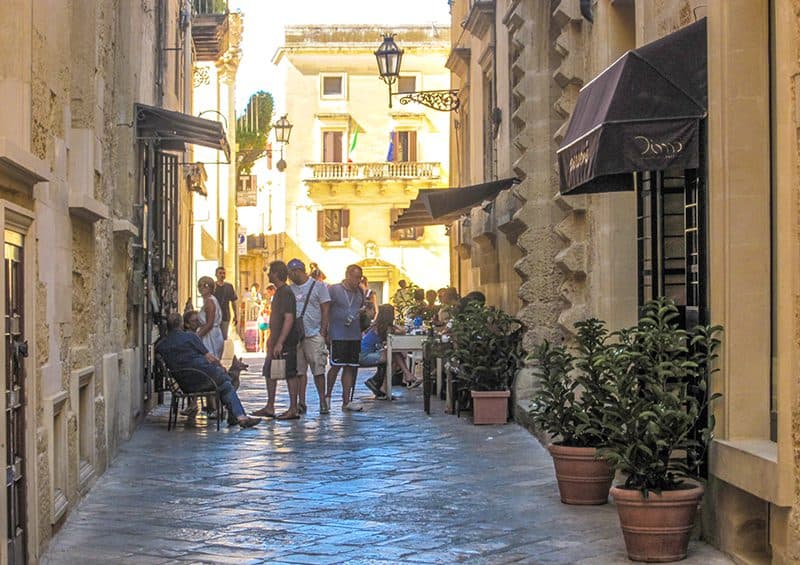
Puglia is perfect for an Italian road trip on the country’s Adriatic coast…it’s a little, and for many, unknown, slice of idyllic, sun-baked Italia…la dolce vita that enamored so many travelers in Italy a half century ago.
Estimated reading time: 8 minutes
By Jim Ferri
Puglia’s northern tip on the east side of Italy is approximately the exact longitude as Naples. In the south, it’s the heel of Italy’s geographic boot at Santa Maria di Leuca. That’s at the cape that splits the Adriatic and Ionian Seas.
Moreover, it’s a relatively small area. It’s only a four-hour drive north to south, barely an hour east to west. So it’s a great place to take a road trip in Italy with some planning. The map of Puglia below provides a good sense of the geography.
Geography aside, it’s a delightfully stunning place. In fact, Puglia still retains la dolce vita that enamored so many travelers in Italy a half-century ago. It’s a great place to visit, and a Puglia road trip will let you see one of the top places to visit in Italy.
Known as Apulia to non-Italians, many fall in love with it since it’s unlike most of the rest of the country. The landscape ranges from beautiful beaches (on 500 miles of coast along two seas) to vineyards and olive groves inland.
Moreover, its architecture ranges from medieval villages to Italy’s most ostentatious Baroque architecture. And the food and wine are nothing short of delizioso.
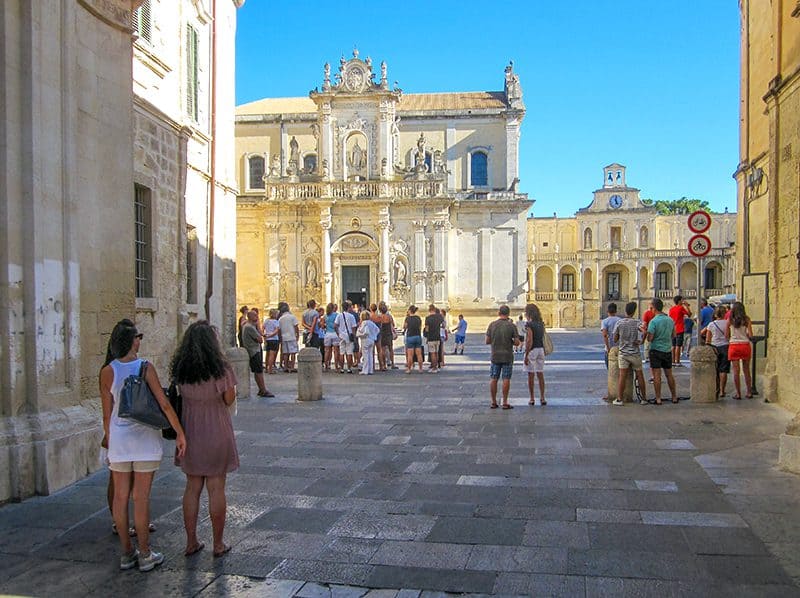
Lecce: Italy’s Baroque City, a Must-See on a Puglia Road Trip
Well-known to travelers in Puglia is Lecce, a Baroque city on the Adriatic coast of Italy. Lecce, also one of the hidden gems of Italy, is an ancient Greek settlement that was an important center for the Romans and an educational center in the Middle Ages.
Thankfully, it’s a place without hordes of tourists, and you’ll rarely see a tour bus. However, what you do see is an area that embraces the influences of centuries of various conquerors (from ancient Greeks to Spaniards) and a landscape that, in some places, looks more Greek than Italian.
It’s best known for the Lecce-Baroque style of architecture, the most exuberant architecture in Italy. A walk around town, viewing its ancient buildings, is an enjoyable way to spend an afternoon. Also, look into its boutiques since the city is well-known for its papier-mâché workshops.
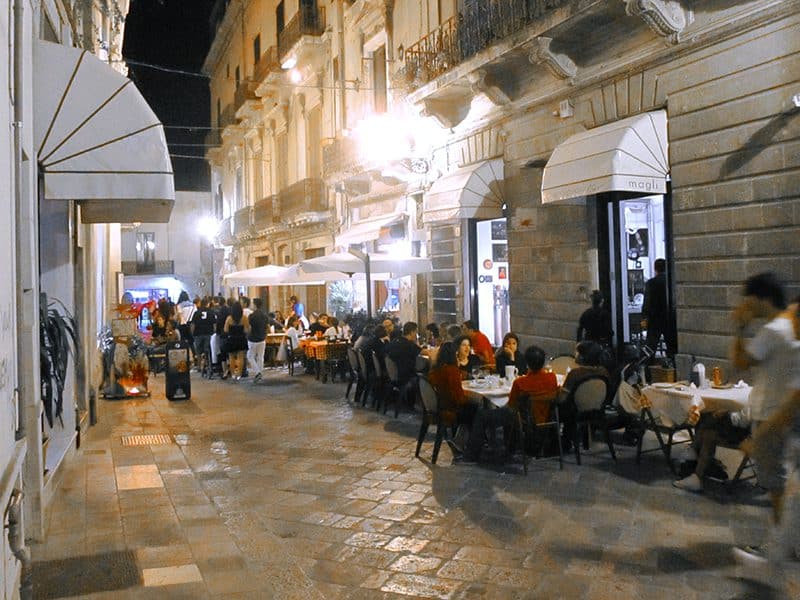
Park the Car and Walk the Ancient Streets of Lecce
You will not be able to drive in the old part of the city in Lecce. That’s fine because you’ll really enjoy your walk.
In the center of town on the Piazza Sant’Oronzo is a Roman amphitheater dating from Emperor Hadrian’s time. Discovered in the 1930s, it’s still undergoing restoration.
From it, walk up Via Vittorio Emanuele, and you’ll come to the Piazza Duomo in just a few minutes. It’s a beautiful square almost hidden down a little alleyway. The Cathedral of the Madonna Assunta and the Bishop’s Palace and Seminary surround it.
Although Via Emanuele is the main street in this part of town, you’d never know it. It’s narrow, bereft of sidewalks, and lined with cafés and shops as with all the streets in the area. It lends itself well to the city’s rest of the Middle Ages character.
Lecce is a great walking city, and this area is a great place to while away an evening. Countless cafés and restaurants line the streets, and many locals are drawn here, especially for their evening passeggiata. Join them and select a table at any restaurant where you can sit and chat with Italians and other Europeans over a meal.
Map of Puglia: A Driving Tour From Rome Along the Adriatic Coast of Italy
This map of Puglia, Italy depicts a driving tour of the main places mentioned in this article. It is interactive; press +/- to enlarge it or make it smaller. It can also be viewed, and the route followed, on your smartphone.
Santa Maria di Leuca
The sun-baked landscape of the province is more Greek than Italian, and it’s easy to explore on this Puglia road trip. The drive from Lecce to Capo Santa Maria di Leuca, down to the bottom of the heel of Italy’s boot on the Adriatic coast of Italy, is relatively easy. It should be quick, but the traffic light in one tiny town brings everything to a crawl on one stretch.
Where the road meets the sea, you’ll find a large plaza with tourist shops dominated by a lighthouse. A small parking area nearby rewards one with sweeping views over the beautiful Ionian and Adriatic Seas.
Down below, petite Santa Maria di Leuca is flush with tourists seeking the sun of the southern countryside. Its harbor, brimful with yachts, is the last stop for many en route to North Africa and further east.
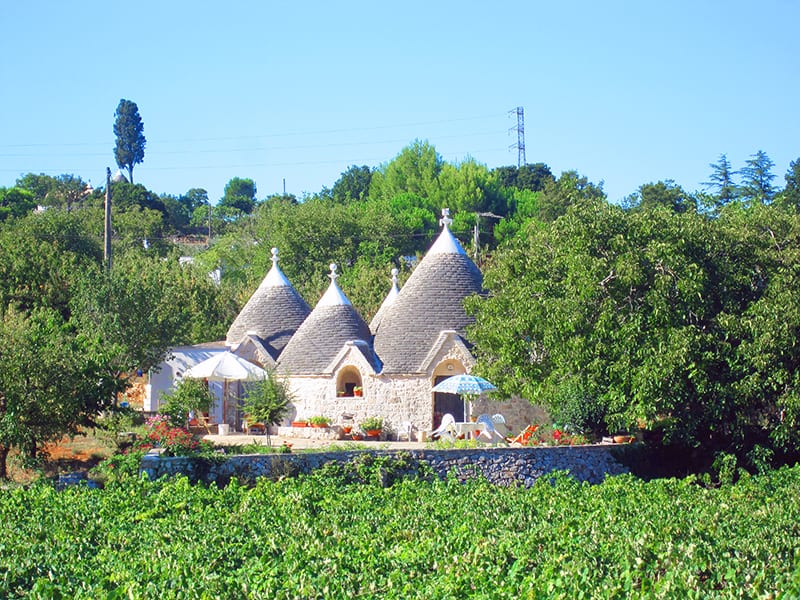
Drive to Alberobello for Its Trulli
If you head north instead, drive E55 up the coast to Alberobello, Puglia, for a taste of the ancient world.
Turn inland at Fasano and take the road up into the hills through the little-whitewashed village of Locorotondo. Then continue to Alberobello, a UNESCO World Heritage Site.
The area’s claim to fame is undoubtedly Alberobello’s trulli, small circular buildings with conical roofs made of slate. They’re ancient buildings with obscure origins, but many have religious, pagan, or magical symbols painted on their sides.
Most have morphed into homes, restaurants, shops, and the occasional vacation rental. There are more than 1,000 of them scattered about Alberobello.
Little lanes, most hardly a car-width wide, run across the hillside vineyards in the countryside around Alberobello. It’s all-picturesque, with orderly low stonewalls and Trulli poking their roofs out of the vineyards. Unfortunately, driving can also be somewhat harrowing if you’re not used to driving on such narrow roads.
Although the town is a bit touristy, it’s worth a quick visit if only to see the famous Alberobello Trulli on its outskirts.
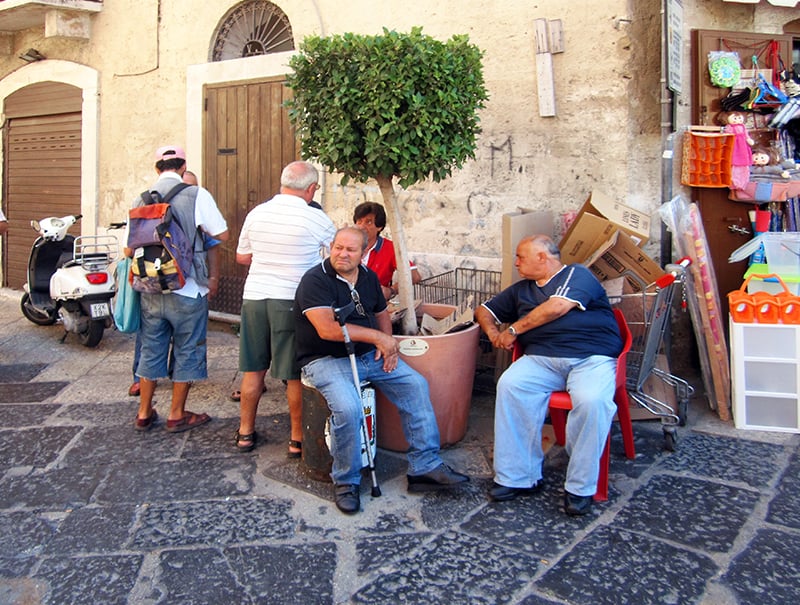
Bari, the Commercial Center
From Alberobello, it’s only about an hour’s drive to Bari on Italy’s Adriatic coast. A thriving commercial center even back in Roman times, it once rivaled Venice as a maritime center.
Most travelers today, however, only know it, and Brindisi, further south along the Adriatic coast of Italy, as the port for ferries to Croatia and Greece. It’s an old port city with only two sites of interest to travelers, both basilicas.
The better know is the Basilica of St. Nicholas, a Norman-designed church dating from 1087. It contains the relics of St. Nicholas, the city’s patron saint.
We decided instead to visit the underdog, the Cathedral of Bari, just a five-minute walk away. Built-in the late 12th century, it still retains its medieval air. Its claim to fame is the remains of San Sabino, the original patron saint of the city.
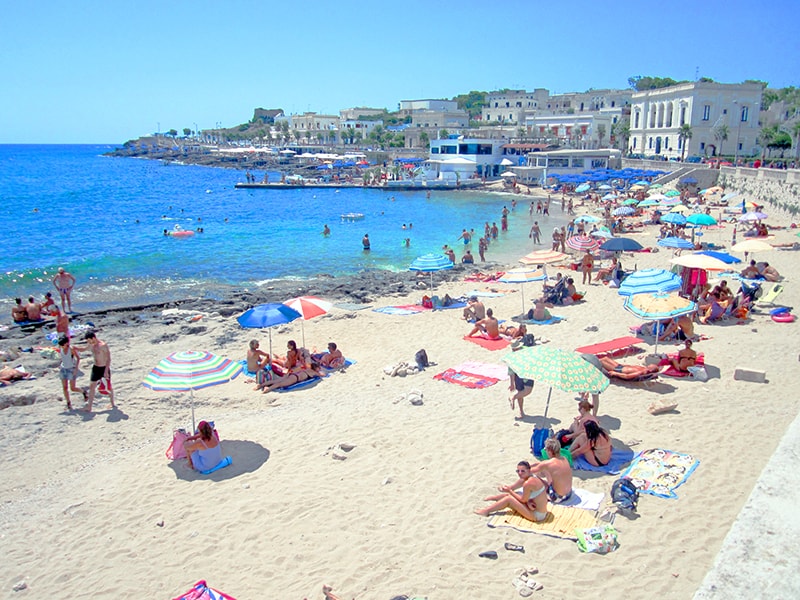
Puglia’s Adriatic Coast
North of Bari, along Italy’s Adriatic coast, is the Gargano Peninsula, a spur-like bit of land jutting into the sea. From a distance, it looks more like an island; it also differs in looks from the surrounding area.
It’s a rocky, dramatic place with a shoreline flecked with coves and cliffs and a heavily wooded interior. The entire area has been designated a National Park to preserve it from development.
Puglia is more accessible than one would think. In fact, you can fly from Rome to Bari or Brindisi in only 1¼ hours.
Instead, you may want to drive across the mountains from Rome to Pescara, a beautiful trip. Then go south along the scenic Adriatic coast of Italy to Puglia for another 1½ hours. Simply follow the interactive map of Puglia above.
A road trip in Puglia is a beautiful drive. And you’ll likely be the first among your friends to take it.
If You Go:
Regione Puglia
Department Mediterranean – Culture – Tourism
http://www.viaggiareinpuglia.it
Italian National Tourist Board
New York
686 Park Avenue – 3rd Floor
New York, NY 10065
@ [email protected]
Los Angeles
10850 Wilshire Boulevard Suite 575
Los Angeles, CA 90024
@ [email protected]
Toronto
365 Bay Street – Suite 503
Toronto (Ontario) M5H 2V1
@ [email protected]

Leave a Reply